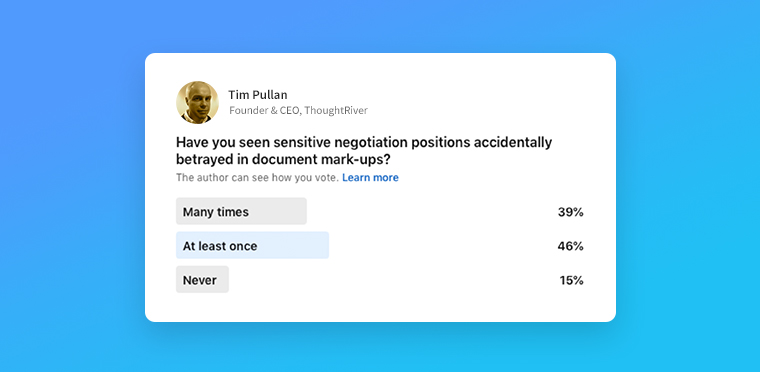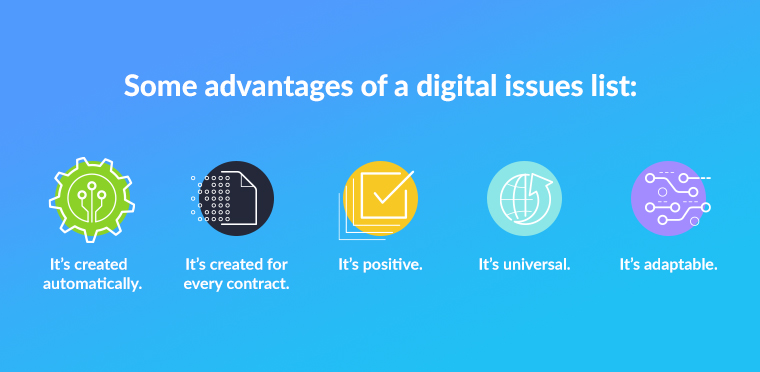Redlining as negotiation can actually create more problems than it solves, so is it time to advance to a digital issues list to focus on the essence of the matter and prevent unnecessary delays?
Common redlining problems
You’ll almost certainly have heard the term ‘redlining’ before, but on the off-chance you haven’t, we’re talking about the standard technique that lawyers use when communicating changes to legal documents.
Deleted wording is struck through, questions are ringed around suspect phrases, and new wording is underlined so the other party can see the terms you’ve added. The other party then sends their response, and the back-and-forth continues until all red marks have been removed and the contract is satisfactory to both sides.
This process has never been fool-proof. Even in the age of Microsoft Word, whose track changes feature enables you to indicate your desired corrections and convey them in a matter of seconds, it’s all too easy to become bogged down in misunderstandings.
In many negotiations a contract can pass through several pairs of hands. With so many people going through the document with a fine-tooth comb, the process can be held up for any number of avoidable reasons.
- There may be two separate versions of the contract: a ‘tracked’ version, showing the changes and a final, ‘clean’ version. But if one side updates the tracked version without amending the final document, this can lead to individual changes being overlooked.
- One side may search for keywords using the ‘Ctrl-F’ function, and end up inserting that keyword into different parts of the document, distorting its meaning.
- When updating the text in the contractual document, a lawyer may accidentally delete the reference that particular passage was based on, thereby denying the other side the context they need.
- One side may choose to create a new version of the document, but end up sending the old one back, so the other party wastes hours, even days reviewing a document which has already been rendered obsolete.
This happens more often than you may think. Our founder and CEO, Tim Pullan, conducted an informal poll on LinkedIn asking about how often lawyers had seen sensitive data unintentionally displayed in contract mark-ups. Only 15% responded that it had never happened to them. Almost 40% said it had occurred many times.

Redlining can focus on what you don’t want, not what you do
Even without these technical glitches, redlining can drain huge amounts of time from the deal-making process. The other party is likely to come back with plenty of their own markups, or they may spend days or weeks answering a particular question. Even if they understand your changes fully, they may still misinterpret the meaning behind them. In the end, the delays can pile up; in our experience, a single markup may take two weeks to resolve.
In fact the whole process of redlining is inimical to effective negotiation, the kind that delivers speedy closure and good, lasting relationships between the parties. Instead of your counterparty setting out their core goals, giving a positive framework for negotiations, they’re giving you very specific examples of what they don’t want, without necessarily providing any context. It’s a breeding ground for confusion, frustration and breakdowns in communications.
Why change how you redline now?
At this point you might be thinking “so what? I’m aware of redlining flaws, but why should I change now?”
There are two good reasons. First, we’re witnessing a boom in corporate dealmaking. Across Europe, M&A volumes in Q3 were up 100% on last year. The global market for initial public offerings has reached its highest level in two decades. Money is flooding into all kinds of sectors, from technology to wine cultivation. Post-pandemic optimism is fuelling an insatiable demand for buyouts, takeovers and strategic investments.
This means, in a world where lawyers are always busy already, there’s a good chance that it will soon get even busier.
Second, technology is emerging that makes redlining and issues management a breeze rather than a struggle. Painful manual tasks can be replaced by automated technology. And as dealmaking pipelines begin to overflow, what better time to rethink how lawyers approach contracting and redlining?
Don’t just highlight the risks: maximise the opportunities
When scrutinising contracts, a lawyer’s guiding goal has always been accuracy: ensuring that every single clause and sub-clause does not pose undue risk for the business.
This has not changed. Precision can never be compromised. But it’s no longer the only factor at play, because speed and efficiency are also key concerns.
Companies are rushing to ink their agreements at an ever-faster pace. You may have read about the phenomenon of 48-hour M&A auctions, with deals passing from initial contact to completion in the space of just two days. And there’s a simple reason for this: companies know that if they don’t clinch their acquisition as soon as possible, someone else may, and probably will, rush in to gazump them.
Competition is higher than ever (thanks, in no small part, to the remarkable growth in private equity) and the development of e-signature software, digital registration platforms, and other breakthrough technologies allows eagle-eyed investors to steal a deal in double-quick time. Simona Maellae, the global co-head of USB’s alternative capital group, says: “It is becoming an execution game, and those who are faster win.”
This represents a fundamental shift in a lawyer’s role. When dealing with contracts (indeed, when handling any aspect of corporate work) you’re the voice of reason who acts to prevent any future problems. The minutiae of the deal, the little words and phrases that can damage your employer’s interest… this is the language you speak, the language that can secure your company’s long-term health.
But there’s no point being fluent in a language that everyone else has stopped speaking.
Effective deal-making isn’t just about downside risk anymore. It’s also about upside opportunity, ensuring you get the deal done before someone else can swoop in. Your employers need you to ensure contracts are agreed as quickly as possible.
There is also the practical issue of determining how best to manage the work that’s delivered to your in-tray. Which activities will add the most value to the company?
Putting the business to one side, which tasks are the most enjoyable and personally satisfying to you? How can you remove the grind and spend more time on high-value activities while still achieving your core objectives?
The answer lies in rethinking how you use technology, how this can recalibrate your strategy to align with the rest of the business, and how you approach the practice of redlining.
Escaping the legal silo
We know that the ideal scenario for a GC is to be an agent of organisational change. A senior figure who does more than provide technical advice and oversees corporate governance, and is an active member of the C-suite.
Unfortunately, this isn’t always the case. The legal industry remains a highly distinct specialism, a self-staffing, self-training and self-appraising sector. In-house lawyers are often cut off from the rest of the business, viewed with a suspicion that stems from outdated perceptions of your role. As the Artificial Lawyer website asked, How Does Legal Innovation Escape The Silo We Are In?
It’s easy for lawyers who are trapped in this silo, isolated from the primary decision-makers, to miss the point when redlining. For example, your counterparty may fixate on pedantic points which, while technically relevant to their business, won’t make any difference to the final contract. By spending unnecessary time negotiating these irrelevant differences with you, they undermine the big picture: winning the contract and winning the deal.
Occasionally, the lawyer is the main decision-maker in the company, so they are wired into the core objectives when refining contracts. But what if there are various decision-makers to consult? In this case, if there is a hold-up during the redlining phase, the lawyer will have to liaise with all the key stakeholders to resolve the problem. And this is time the company cannot afford to waste.
How it pays to automate a digital issues list
In light of these various flaws, we believe that there is a better alternative to redlining: an automated, digital version of the issues list.
Lawyers have long used the issues list to guide them in negotiation. The document is usually drafted in collaboration with key stakeholders, to ensure universal buy-in. In its simplest form, the list will identify the issues that most matter to the company and define a way to resolve each issue to the company’s satisfaction. As Prof. Seth Freeman notes in his excellent primer on the subject, an issues list will provide the following key information for all key points of discussion:
- What your company wants
- What the other company wants
- What are the best and worst outcomes for your side
This list is ideal for lawyers. It ensures that you are fully appraised of all the company’s key priorities and can use them to guide your approach to contract revision. Rather than spending hours making low-value and time-consuming amends, you can limit your focus to those issues that matter most to your business, and ensure the revision process is as quick as possible. Instead of focusing on pedantic and irrelevant points, you’re constantly working towards specific outcomes that will enable your employer to maximise the potential of the deal.
The main drawback of the traditional issues list is that it takes time and effort to create and manage it. However, the application of legal technology enables you to create something better: a digital issues list that can be stored in the Cloud and accessible to everyone.
The advantages are manifold. Here are some of the most powerful.

It’s created automatically. With the right technology there’s no need to spend valuable time drafting and issuing a list of snags. ThoughtRiver runs an automated risk review and creates an issues list as an output every time, so you can dedicate more time to resolving issues than logging them.
It’s created for every contract. Due to the effort involved, it’s tempting to overlook an issues list for relatively small or low-value transactions – even though creating an issues list is recognised best practice procedure. With an automatically created list, you can ensure best practice is adhered to for every contract.
It’s positive. The issues list allows you to define your contracts positively, rather than negatively. It shows you what the company wants to achieve, giving you a framework to work towards when reviewing contracts.
It’s universal. Anyone in the business can access the list, providing they have the right log-in credentials. So the problem of in-house lawyers being disconnected from the C-suite (and thus unable to implement its key objectives in contract negotiations) is rendered an irrelevance; everyone is working to the same core objectives, and you can collaborate internally to resolve any disputes in a matter of minutes.
It’s adaptable. A digital issues list can be adapted to specific contracts and updated in response to the business’s changing goals. In a world defined by speed of execution, this kind of flexibility isn’t just beneficial; it’s essential.
Remove the manual grind from contract negotiations
A digital issues list ensures that you arrive at each contract ready to go. You know exactly what your priorities are and you have set parameters to achieve them. As the pace of dealmaking continues to increase, as your competitors continue to prioritise speed when inking their key agreements, an automated digital issues list enables you to keep pace without risking the company’s long-term interest.





